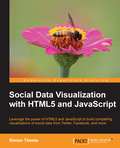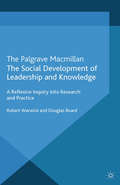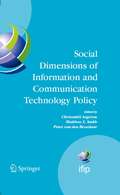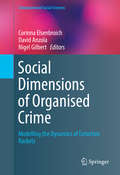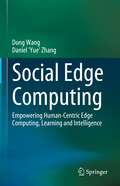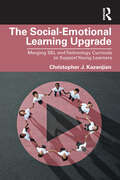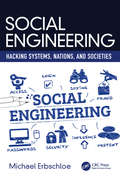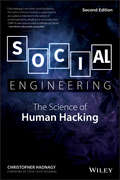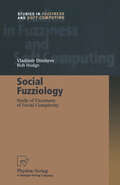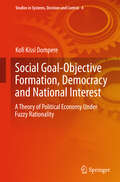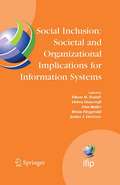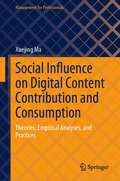- Table View
- List View
Social Data Visualization with HTML5 and JavaScript
by Simon TimmsThis book is a fast-paced guide full of step-by-step instructions that teach you how to visualize social data using HTML5 and JavaScript.This book is for developers who are excited about data and who want to share that excitement with others. Developers who are interested in the data which can be extracted from social networks will also find this book hugely beneficial.Readers should have a working knowledge of both JavaScript and HTML.
The Social Development of Leadership and Knowledge: A Reflexive Inquiry into Research and Practice
by R. Warwick D. BoardIn an increasingly complex and interconnected world, the authors make a case rich in theory and narrative for a new reflexive approach to real life situations. This approach (immersed reflexivity) draws on Pierre Bourdieu's logic of practice and the complexity sciences.
Social Dimensions of Information and Communication Technology Policy: Proceedings of the Eighth International Conference on Human Choice and Computers (HCC8), IFIP TC 9, Pretoria, South Africa, September 25-26, 2008 (IFIP Advances in Information and Communication Technology)
by Chrisanthi Avgerou Matthew L. Smith Peter Van Den BesselaarThis book constitutes the proceedings of the 8th International Conference on Human Choice and Computers held in Pretoria, South Africa. The IFIP series publishes state-of-the-art results in the sciences and technologies of information and communication. The scope of the series includes: foundations of computer science; software theory and practice; education; computer applications in technology; communication systems; systems modeling and optimization; information systems; computers and society; computer systems technology; security and protection in information processing systems; artificial intelligence; and human-computer interaction. Proceedings and post-proceedings of refereed international conferences in computer science and interdisciplinary fields are featured. These results often precede journal publication and represent the most current research. The principal aim of the IFIP series is to encourage education and the dissemination and exchange of information about all aspects of computing.
Social Dimensions of Organised Crime: Modelling the Dynamics of Extortion Rackets (Computational Social Sciences)
by Corinna Elsenbroich David Anzola Nigel GilbertThis book presents a multi-disciplinary investigation into extortion rackets with a particular focus on the structures of criminal organisations and their collapse, societal processes in which extortion rackets strive and fail and the impacts of bottom-up and top-down ways of fighting extortion racketeering. Through integrating a range of disciplines and methods the book provides an extensive case study of empirically based computational social science. It is based on a wealth of qualitative data regarding multiple extortion rackets, such as the Sicilian Mafia, an international money laundering organisation and a predatory extortion case in Germany. Computational methods are used for data analysis, to help in operationalising data for use in agent-based models and to explore structures and dynamics of extortion racketeering through simulations. In addition to textual data sources, stakeholders and experts are extensively involved, providing narratives for analysis and qualitative validation of models. The book presents a systematic application of computational social science methods to the substantive area of extortion racketeering. The reader will gain a deep understanding of extortion rackets, in particular their entrenchment in society and processes supporting and undermining extortion rackets. Also covered are computational social science methods, in particular computationally assisted text analysis and agent-based modelling, and the integration of empirical, theoretical and computational social science.
Social Edge Computing: Empowering Human-Centric Edge Computing, Learning and Intelligence
by Dong Wang Daniel 'Yue' ZhangThe rise of the Internet of Things (IoT) and Artificial Intelligence (AI) leads to the emergence of edge computing systems that push the training and deployment of AI models to the edge of networks for reduced bandwidth cost, improved responsiveness, and better privacy protection, allowing for the ubiquitous AI that can happen anywhere and anytime. Motivated by the above trend, this book introduces a new computing paradigm, the Social Edge Computing (SEC), that empowers human-centric edge intelligent applications by revolutionizing the computing, intelligence, and the training of the AI models at the edge. The SEC paradigm introduces a set of critical human-centric challenges such as the rational nature of edge device owners, pronounced heterogeneity of the edge devices, real-time AI at the edge, human and AI interaction, and the privacy of the edge users. The book addresses these challenges by presenting a series of principled models and systems that enable the confluence of the computing capabilities of devices and the domain knowledge of the people, while explicitly addressing the unique concerns and constraints from humans. Compared to existing books in the field of edge computing, the vision of this book is unique: we focus on the social edge computing (SEC), an emerging paradigm at the intersection of edge computing, AI, and social computing. This book discusses the unique vision, challenges and applications in SEC. To our knowledge, keeping humans in the loop of edge intelligence has not been systematically reviewed and studied in an existing book. The SEC vision generalizes the current machine-to-machine interactions in edge computing (e.g., mobile edge computing literature), and machine-to-AI interactions (e.g., edge intelligence literature) into a holistic human-machine-AI ecosystem.
The Social-Emotional Learning Upgrade: Merging SEL and Technology Curricula to Support Young Learners
by Christopher J. KazanjianThe Social-Emotional Learning Upgrade explores how today’s educators can connect two previously separated but important curricula in their schools: social-emotional learning (SEL) and educational technology. With schools’ SEL efforts pressed for time and resources and digital engagements often limited to skill development, K-12 students risk being unprepared to sustain their well-being and personal opportunities in a rapidly changing, technology-dependent world. Driven by a paradigm that synthesizes multicultural education and humanistic psychology, this book readies educators to implement SEL curricula that will support young learners as they navigate constant social and technological flux and that will nurture their unique perceptions of reality, their aspirations, and their mental and physical health. Each chapter’s novel insights will help to mitigate both student disengagement and teacher demoralization, enabling classroom pedagogies and the process of schooling to better align with the ways in which learners explore, express, and create meaning. Guiding pre-service teachers, leaders, and curriculum developers beyond common goals such as digital skills development, content mastery, or standardized testing, this volume focuses instead on complex digital literacies, collaborative experiences, problem- and project-based learning, culturally relevant pedagogies, and overall holistic growth.
The Social-Emotional Learning Upgrade: Merging SEL and Technology Curricula to Support Young Learners
by Christopher J. KazanjianThe Social-Emotional Learning Upgrade explores how today’s educators can connect two previously separated but important curricula in their schools: social-emotional learning (SEL) and educational technology. With schools’ SEL efforts pressed for time and resources and digital engagements often limited to skill development, K-12 students risk being unprepared to sustain their well-being and personal opportunities in a rapidly changing, technology-dependent world. Driven by a paradigm that synthesizes multicultural education and humanistic psychology, this book readies educators to implement SEL curricula that will support young learners as they navigate constant social and technological flux and that will nurture their unique perceptions of reality, their aspirations, and their mental and physical health. Each chapter’s novel insights will help to mitigate both student disengagement and teacher demoralization, enabling classroom pedagogies and the process of schooling to better align with the ways in which learners explore, express, and create meaning. Guiding pre-service teachers, leaders, and curriculum developers beyond common goals such as digital skills development, content mastery, or standardized testing, this volume focuses instead on complex digital literacies, collaborative experiences, problem- and project-based learning, culturally relevant pedagogies, and overall holistic growth.
Social Engineering: Hacking Systems, Nations, and Societies
by Michael ErbschloeThis book analyzes of the use of social engineering as a tool to hack random systems and target specific systems in several dimensions of society. It shows how social engineering techniques are employed well beyond what hackers do to penetrate computer systems. And it explains how organizations and individuals can socially engineer their culture to help minimize the impact of the activities of those who lie, cheat, deceive, and defraud. After reading this book, you’ll be able to analyze how organizations work and the need for security to maintain operations and sustainability, and be able to identify, respond to and counter socially engineered threats to security.
Social Engineering: Hacking Systems, Nations, and Societies
by Michael ErbschloeThis book analyzes of the use of social engineering as a tool to hack random systems and target specific systems in several dimensions of society. It shows how social engineering techniques are employed well beyond what hackers do to penetrate computer systems. And it explains how organizations and individuals can socially engineer their culture to help minimize the impact of the activities of those who lie, cheat, deceive, and defraud. After reading this book, you’ll be able to analyze how organizations work and the need for security to maintain operations and sustainability, and be able to identify, respond to and counter socially engineered threats to security.
Social Engineering: The Science of Human Hacking
by Christopher HadnagyHarden the human firewall against the most current threats Social Engineering: The Science of Human Hacking reveals the craftier side of the hacker’s repertoire—why hack into something when you could just ask for access? Undetectable by firewalls and antivirus software, social engineering relies on human fault to gain access to sensitive spaces; in this book, renowned expert Christopher Hadnagy explains the most commonly-used techniques that fool even the most robust security personnel, and shows you how these techniques have been used in the past. The way that we make decisions as humans affects everything from our emotions to our security. Hackers, since the beginning of time, have figured out ways to exploit that decision making process and get you to take an action not in your best interest. This new Second Edition has been updated with the most current methods used by sharing stories, examples, and scientific study behind how those decisions are exploited. Networks and systems can be hacked, but they can also be protected; when the “system” in question is a human being, there is no software to fall back on, no hardware upgrade, no code that can lock information down indefinitely. Human nature and emotion is the secret weapon of the malicious social engineering, and this book shows you how to recognize, predict, and prevent this type of manipulation by taking you inside the social engineer’s bag of tricks. Examine the most common social engineering tricks used to gain access Discover which popular techniques generally don’t work in the real world Examine how our understanding of the science behind emotions and decisions can be used by social engineers Learn how social engineering factors into some of the biggest recent headlines Learn how to use these skills as a professional social engineer and secure your company Adopt effective counter-measures to keep hackers at bay By working from the social engineer’s playbook, you gain the advantage of foresight that can help you protect yourself and others from even their best efforts. Social Engineering gives you the inside information you need to mount an unshakeable defense.
Social Engineering: The Science of Human Hacking
by Christopher HadnagyHarden the human firewall against the most current threats Social Engineering: The Science of Human Hacking reveals the craftier side of the hacker’s repertoire—why hack into something when you could just ask for access? Undetectable by firewalls and antivirus software, social engineering relies on human fault to gain access to sensitive spaces; in this book, renowned expert Christopher Hadnagy explains the most commonly-used techniques that fool even the most robust security personnel, and shows you how these techniques have been used in the past. The way that we make decisions as humans affects everything from our emotions to our security. Hackers, since the beginning of time, have figured out ways to exploit that decision making process and get you to take an action not in your best interest. This new Second Edition has been updated with the most current methods used by sharing stories, examples, and scientific study behind how those decisions are exploited. Networks and systems can be hacked, but they can also be protected; when the “system” in question is a human being, there is no software to fall back on, no hardware upgrade, no code that can lock information down indefinitely. Human nature and emotion is the secret weapon of the malicious social engineering, and this book shows you how to recognize, predict, and prevent this type of manipulation by taking you inside the social engineer’s bag of tricks. Examine the most common social engineering tricks used to gain access Discover which popular techniques generally don’t work in the real world Examine how our understanding of the science behind emotions and decisions can be used by social engineers Learn how social engineering factors into some of the biggest recent headlines Learn how to use these skills as a professional social engineer and secure your company Adopt effective counter-measures to keep hackers at bay By working from the social engineer’s playbook, you gain the advantage of foresight that can help you protect yourself and others from even their best efforts. Social Engineering gives you the inside information you need to mount an unshakeable defense.
Social Engineering in Cybersecurity: Threats and Defenses
by Dr Gururaj H L Dr Janhavi V Ambika VIn today’s digitally interconnected world, the threat landscape has evolved to include not just sophisticated technical exploits but also the art of human manipulation. Social engineering attacks have emerged as a formidable and often underestimated threat to information security. The primary aim of this textbook is to provide a comprehensive and in-depth exploration of social engineering attacks. The book seeks to equip cybersecurity professionals, IT practitioners, students, and anyone concerned with information security with the knowledge and tools needed to recognize, prevent, and mitigate the risks posed by social engineering. The scope of this textbook is broad and multifaceted. It covers a wide range of social engineering attack vectors, including phishing, vishing, pretexting, baiting, tailgating, impersonation, and more. Each attack vector is dissected, with detailed explanations of how they work, real-world examples, and countermeasures. Key Features • Comprehensive Coverage: Thorough exploration of various social engineering attack vectors, including phishing, vishing, pretexting, baiting, quid pro quo, tailgating, impersonation, and more. • Psychological Insights: In-depth examination of the psychological principles and cognitive biases that underlie social engineering tactics. • Real-World Case Studies: Analysis of real-world examples and high-profile social engineering incidents to illustrate concepts and techniques.• Prevention and Mitigation: Practical guidance on how to recognize, prevent, and mitigate social engineering attacks, including security best practices. • Ethical Considerations: Discussion of ethical dilemmas and legal aspects related to social engineering that emphasizes responsible use of knowledge. This comprehensive textbook on social engineering attacks provides a deep and practical exploration of this increasingly prevalent threat in cybersecurity. It covers a wide array of attack vectors, including phishing, vishing, pretexting, and more, offering readers an in-depth understanding of how these attacks work. The book delves into the psychology behind social engineering and examines the cognitive biases and emotional triggers that make individuals susceptible. Real-world case studies illustrate concepts and techniques while practical guidance equips readers with the knowledge to recognize, prevent, and mitigate social engineering threats.
Social Engineering in Cybersecurity: Threats and Defenses
In today’s digitally interconnected world, the threat landscape has evolved to include not just sophisticated technical exploits but also the art of human manipulation. Social engineering attacks have emerged as a formidable and often underestimated threat to information security. The primary aim of this textbook is to provide a comprehensive and in-depth exploration of social engineering attacks. The book seeks to equip cybersecurity professionals, IT practitioners, students, and anyone concerned with information security with the knowledge and tools needed to recognize, prevent, and mitigate the risks posed by social engineering. The scope of this textbook is broad and multifaceted. It covers a wide range of social engineering attack vectors, including phishing, vishing, pretexting, baiting, tailgating, impersonation, and more. Each attack vector is dissected, with detailed explanations of how they work, real-world examples, and countermeasures. Key Features • Comprehensive Coverage: Thorough exploration of various social engineering attack vectors, including phishing, vishing, pretexting, baiting, quid pro quo, tailgating, impersonation, and more. • Psychological Insights: In-depth examination of the psychological principles and cognitive biases that underlie social engineering tactics. • Real-World Case Studies: Analysis of real-world examples and high-profile social engineering incidents to illustrate concepts and techniques.• Prevention and Mitigation: Practical guidance on how to recognize, prevent, and mitigate social engineering attacks, including security best practices. • Ethical Considerations: Discussion of ethical dilemmas and legal aspects related to social engineering that emphasizes responsible use of knowledge. This comprehensive textbook on social engineering attacks provides a deep and practical exploration of this increasingly prevalent threat in cybersecurity. It covers a wide array of attack vectors, including phishing, vishing, pretexting, and more, offering readers an in-depth understanding of how these attacks work. The book delves into the psychology behind social engineering and examines the cognitive biases and emotional triggers that make individuals susceptible. Real-world case studies illustrate concepts and techniques while practical guidance equips readers with the knowledge to recognize, prevent, and mitigate social engineering threats.
Social Engineering Penetration Testing: Executing Social Engineering Pen Tests, Assessments and Defense
by Gavin Watson Andrew Mason Richard AckroydSocial engineering attacks target the weakest link in an organization's security human beings. Everyone knows these attacks are effective, and everyone knows they are on the rise. Now, Social Engineering Penetration Testing gives you the practical methodology and everything you need to plan and execute a social engineering penetration test and assessment. You will gain fascinating insights into how social engineering techniques including email phishing, telephone pretexting, and physical vectors can be used to elicit information or manipulate individuals into performing actions that may aid in an attack. Using the book's easy-to-understand models and examples, you will have a much better understanding of how best to defend against these attacks. The authors of Social Engineering Penetration Testing show you hands-on techniques they have used at RandomStorm to provide clients with valuable results that make a real difference to the security of their businesses. You will learn about the differences between social engineering pen tests lasting anywhere from a few days to several months. The book shows you how to use widely available open-source tools to conduct your pen tests, then walks you through the practical steps to improve defense measures in response to test results. - Understand how to plan and execute an effective social engineering assessment - Learn how to configure and use the open-source tools available for the social engineer - Identify parts of an assessment that will most benefit time-critical engagements - Learn how to design target scenarios, create plausible attack situations, and support various attack vectors with technology - Create an assessment report, then improve defense measures in response to test results
Social Entrepreneurship and Social Inclusion: Processes, Practices, and Prospects
by Rama Krishna KummithaThis book argues that embeddedness and community participation bring unique propositions for social entrepreneurship to foster social inclusion. It uncovers the role of local knowledge and grassroots level innovations to create necessary environment for the positive social change to roll. Social enterprises have proven to reduce drudgery of poor and excluded by offering creative and innovative solutions for long standing social problems. The grassroots level creative problem solving mechanisms they initiate travel through a variety of local dynamics and cultural contexts. However, social innovations quite often do not achieve their intended results, especially when they fail to understand the local contexts and embed themselves in such dynamism. In this background, the book attempts to understand and analyse the 'connect' between the social innovations and local dynamism. It argues that the community-driven innovation management which is based on local knowledge inspires the social entrepreneurial process and builds capacities and infrastructure to foster social inclusion. Each chapter in this book offers development scholars rich narration about how social problems have been approached, addressed, and altered through rich insights from communities and the social entrepreneurial teams.
Social Entrepreneurship and Social Inclusion: Processes, Practices, and Prospects
by Rama Krishna KummithaThis book argues that embeddedness and community participation bring unique propositions for social entrepreneurship to foster social inclusion. It uncovers the role of local knowledge and grassroots level innovations to create necessary environment for the positive social change to roll. Social enterprises have proven to reduce drudgery of poor and excluded by offering creative and innovative solutions for long standing social problems. The grassroots level creative problem solving mechanisms they initiate travel through a variety of local dynamics and cultural contexts. However, social innovations quite often do not achieve their intended results, especially when they fail to understand the local contexts and embed themselves in such dynamism. In this background, the book attempts to understand and analyse the 'connect' between the social innovations and local dynamism. It argues that the community-driven innovation management which is based on local knowledge inspires the social entrepreneurial process and builds capacities and infrastructure to foster social inclusion. Each chapter in this book offers development scholars rich narration about how social problems have been approached, addressed, and altered through rich insights from communities and the social entrepreneurial teams.
Social Fuzziology: Study of Fuzziness of Social Complexity (Studies in Fuzziness and Soft Computing #107)
by Vladimir Dimitrov Bob HodgeFuzziology studies the fuzziness inherent in what we know about ourselves, the sources and nature of our experience, our thoughts and feelings, drives for understanding and urges to create and realise our potential. This kind of fuzziness is at the core of our existence, at the essence of our humanness. It affects any field of human activity, be it mathematical study of fuzzy equations and fuzzy integrals; engineering design and implementation of fuzzy logic-based methodologies; fuzzy control systems or fuzzy robots. Social fuzziology investigates the role of fuzziness in understanding the dynamic complexity of human existence in the social world. It is a study of the nexus between the complex demands of life -individual and social -and the fuzziness of thinking. Since human evolution over 2 billion years has seen the co-evolution of social complexity with human language and thought, it is likely that the fuzziness of language and thought is especially intimately formed by the demands of social complexity, just as social complexity is sustained by the inherent fuzziness of language and thought. Social fuzziology is not simply one field of application of fuzziology. Given the initial state of the development of fuzziology, social fuzziology needs to develop hand in hand with fuzziology, each helping to advance the other.
Social Goal-Objective Formation, Democracy and National Interest: A Theory of Political Economy Under Fuzzy Rationality (Studies in Systems, Decision and Control #4)
by Kofi Kissi DompereThis book presents the development of a theory of social goal-objective formation and its relationship to national interest and social vision under a democratic decision-choice system with imperfect information structure. It provides a framework for the application of fuzzy logic and its mathematics to the analysis in resolving conflicts in individual preferences in the collective decision-choice space without violence. The book demonstrates how to use fuzzy logic and its mathematics in the study of economics, social sciences and other complex systems. It also presents the use of collaborative tools of opposites, duality, polarity, continuum in fuzzy paradigm with its logic, laws of thought and mathematics in developing a new approach to the theory of political economy in order to enhance the constructs of social decision-choice theory.
Social goes Mobile - Kunden gezielt erreichen: Mobile Marketing in Sozialen Netzwerken
by Heike ScholzIn diesem Buch erläutern ausgewiesene Digital-Profis, wie Unternehmen ihre Kunden zielsicher mobil in Sozialen Netzwerken erreichen und daraus den größtmöglichen Profit ziehen können. Denn: Mobile Geräte wie Smartphones, Tablets, Phablets oder Smartwatches sind zu ständigen Begleitern geworden und besetzen jeden denkbaren Nutzungskontext. Insbesondere Social Networks werden intensiv auf mobilen Devices genutzt – eine große Chance für Unternehmen, ihre Zielgruppen in persönlichen Momenten abzuholen. Dieses Buch liefert wertvolles Wissen und praktische Tipps für alle, die ihre mobilen Social-Media-Aktivitäten optimal und punktgenau gestalten wollen: von rechtlichen Basics über Messenger Marketing und Live Streaming bis hin zu nützlichen Tools, mobiler Suchmaschinenoptimierung sowie Monitoring- und Controlling-Ansätzen.
Social Group Utility Maximization (SpringerBriefs in Electrical and Computer Engineering)
by Xiaowen Gong Xu Chen Lei Yang Junshan ZhangThis SpringerBrief explains how to leverage mobile users' social relationships to improve the interactions of mobile devices in mobile networks. It develops a social group utility maximization (SGUM) framework that captures diverse social ties of mobile users and diverse physical coupling of mobile devices. Key topics include random access control, power control, spectrum access, and location privacy. This brief also investigates SGUM-based power control game and random access control game, for which it establishes the socially-aware Nash equilibrium (SNE). It then examines the critical SGUM-based spectrum access game, and pseudonym change game for personalized location privacy. The authors propose future work on extending the SGUM framework to negative social ties, to demonstrate relevance to security applications and span the continuum between zero-sum game (ZSG) and non-cooperative game (NCG). Social Group Utility Maximization targets researchers and professionals working on mobile networks and social networks. Advanced-level students in electrical engineering and computer science will also find this material useful for their related courses.
Social Inclusion: IFIP TC8 WG 8.2 International Working Conference, July 12-15, 2006, Limerick, Ireland (IFIP Advances in Information and Communication Technology #208)
by Tom Butler Janice DeGross Brian Fitzgerald Debra Howcroft Eileen TrauthThis book presents the proceedings of the Working Conference on the societal and organizational implications for information systems of social inclusion. The contributed papers explore technology design and use in organizations, and consider the processes that engender social exclusion along with the issues that derive from it. The conference, sponsored by the International Federation for Information Processing Working Group 8.2, was held in Limerick, Ireland, in July, 2006.
Social Influence on Digital Content Contribution and Consumption: Theories, Empirical Analyses, and Practices (Management for Professionals)
by Xuejing MaThis book examines users’ digital content contribution and consumption behavior from a social perspective. Digital content is everywhere—from search results on search engines to posts on social media. Incentivizing users to contribute abundant content and motivating users to engage in and pay for digital content are vital for online platforms, especially those relying on digital content generated by users. This book develops a theoretical framework to incorporate social influence, including social presence, social interaction, social comparison, social loafing, and social relationships, in users’ digital content contribution and consumption decisions. Further, using a large volume of data from online platforms, the author empirically studies the role of social interaction in digital content provision and monetization from the supply side. Also, regarding the digital content demand side, this book explores how to boost content consumption via social motives and social norms. The book enriches the understanding of social influence in digital content contribution and consumption and provides practical suggestions for digital platforms’ mechanism design.
Social Informatics: 4th International Conference, SocInfo 2012, Lausanne, Switzerland, December 5-7, 2012, Proceedings (Lecture Notes in Computer Science #7710)
by Karl Aberer Andreas Flache Wander Jager Ling Liu Jie Tang Christophe GueretThis book constitutes the proceedings of the 4th International Conference on Social Informatics, SocInfo 2012, held in Lausanne, Switzerland, in December 2012. The 21 full papers, 18 short papers included in this volume were carefully reviewed and selected from 61 submissions. The papers are organized in topical sections named: social choice mechanisms in the e-society,computational models of social phenomena, social simulation, web mining and its social interpretations, algorithms and protocols inspired by human societies, socio-economic systems and applications, trust, privacy, risk and security in social contexts.
Social Informatics: 6th International Conference, SocInfo 2014, Barcelona, Spain, November 11-13, 2014, Proceedings (Lecture Notes in Computer Science #8851)
by Luca Maria Aiello Daniel McFarlandThis book constitutes the proceedings of the 6th International Conference on Social Informatics, SocInfo 2014, held in Barcelona, Spain, in November 2014. The 28 full papers and 14 short papers presented in this volume were carefully reviewed and selected from 147 submissions. The papers are organized in topical sections such as network, communities, and crowds; interpersonal links and gender biases; news, credibility, and opinion formation; science and technologies; organizations, society and social good.
Social Informatics: SocInfo 2014 International Workshops, Barcelona, Spain, November 11, 2014, Revised Selected Papers (Lecture Notes in Computer Science #8852)
by Luca Maria Aiello Daniel McFarlandThis book constitutes the proceedings of the Workshops held at the International Conference on Social Informatics, SocInfo 2014, which took place in Barcelona, Spain, in November 2014. This year SocInfo 2014 included nine satellite workshops: the City Labs Workshop, the Workshop on Criminal Network Analysis and Mining, CRIMENET, the Workshop on Interaction and Exchange in Social Media, DYAD, the Workshop on Exploration of Games and Gamers, EGG, the Workshop on HistoInformatics, the Workshop on Socio-Economic Dynamics, Networks and Agent-based Models, SEDNAM, the Workshop on Social Influence, SI, the Workshop on Social Scientists Working with Start-Ups and the Workshop on Social Media in Crowdsourcing and Human Computation, SoHuman.
